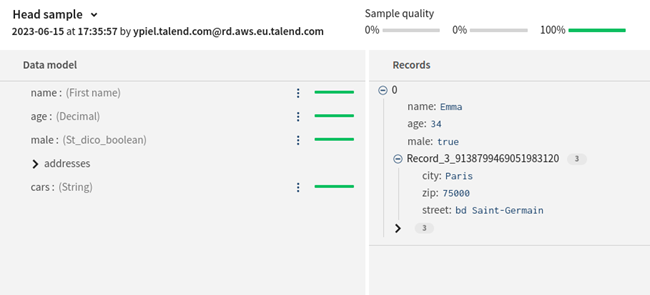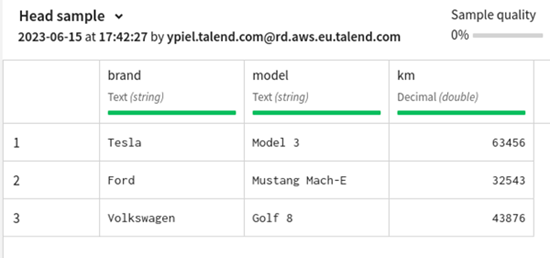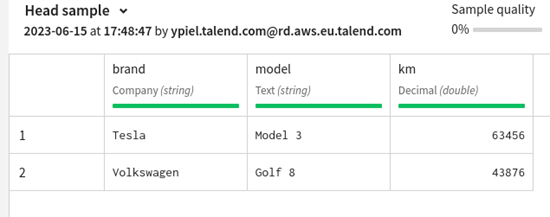Additional information about how to extract data with HTTP Client
[
{
"name": "Peter",
"age": 40,
"male": true,
"addresses": {
"city": "Nantes",
"zip": "44000",
"street": "bd prairie au duc"
},
"cars": [
{"brand": "Ford", "model": "Transit", "km": 123456},
{"brand": "Renault", "model": "Clio", "km": 87234}
]
},
{
"name": "Emma",
"age": 34,
"male": true,
"addresses": {
"city": "Paris",
"zip": "75000",
"street": "bd Saint-Germain"
},
"cars": [
{"brand": "Tesla", "model": "Model 3", "km": 63456},
{"brand": "Ford", "model": "Mustang Mach-E", "km": 32543},
{"brand": "Volkswagen", "model": "Golf 8", "km": 43876},
]
}
]'Extract a sub-part of the response'
This configuration processes the whole response payload and let you extract the sub-element you want to return. If the selector points to an array, it will generate one output record per item.
| Value of 'Extract a sub-part of the response' | Result |
|---|---|
|
<empty> or . or .root (the three values will return the same result) |

|
|
.root[1] If the document is an array (it starts with [ and ends with ]), and you want to extract only one item from it, you can use .root to be able to define the index. Indeed .[1] and [1] are not valid, but .root[1] will extract the second element of the document (index starts at 0). |

|
|
.root[1].cars Allows you to select a sub-array and loop over. Here, the list of cars owned by Emma is selected. |

|
|
.root[1].cars{.km > 40000} Allows you to filter returned elements. Here, the list of cars owned by Emma that have more than 40000 kms is returned. |

|
'Output key/Value pairs'
Once the main data is extracted with the Extract a sub-part of the response parameter, you can also extract some values to create a flat record.
To do so, enable the Output key/value pairs and add some Name / Value entries. Name will be the field's name of the output record, and Value can contain some DSSL selectors to retrieve values from the response of the HTTP query configured in the connector.
In this example, the Extract a sub-part of the response value is '.', so it will loop over the two records 'Peter' and 'Emma':
| Name / Value | Result |
|---|---|
|

|
Did this page help you?
If you find any issues with this page or its content – a typo, a missing step, or a technical error – let us know how we can improve!
